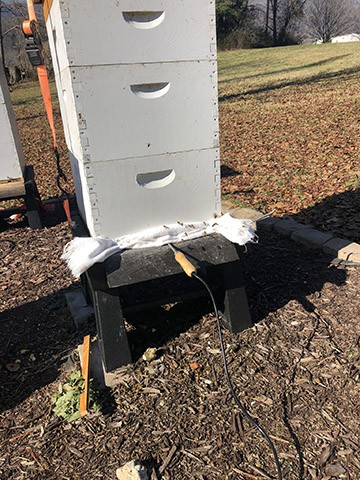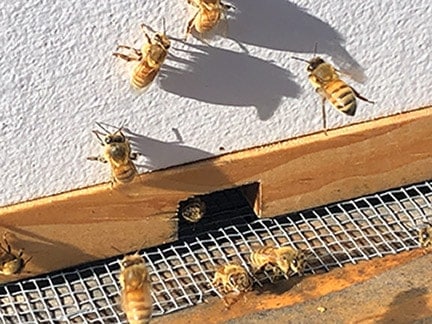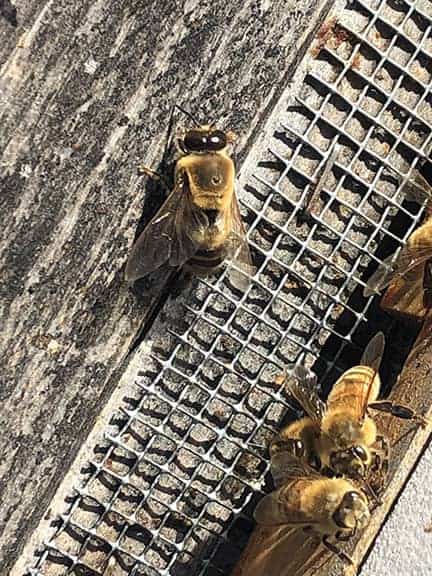Winter Updates from the Hive
What a year it has been in Beorn’s Apiary!
2018 went out with relatively warm weather. In December, we had a combination of weird weather events. In the early part of the month, we experienced a snow storm that had me out in my apiary sweeping off the entrance reducers so the bees would not congregate at the entrance and freeze. We had close to 12 inches of snow when it was all said and done.
I began my treatments with Oxalic Acid and just completed the third vaporization treatment a little over a week ago. Weather again has been the major interruption in my apiary as it was most of the summer. We have had periods of extremely warm weather that has had the bees out and bringing in pollen from something. I believe it is most likely dandelion pollen. But, you never know with the very definite impacts of global warming causing daffodils and other early spring flowers to start popping their heads above ground in January!

Despite treating with Apivar last summer, my colonies proved to have significant Varroa Mite loads after the fall final tests which showed things pretty much in control in all but one hive.
I am hearing anecdotal reports from other folks using Apivar that it was not efficacious in their hives either. I’m likely going to choose an alternative summer treatment method this coming summer. In fact, beekeepers using Apivar in my area have been losing large numbers of hives to varroa mites. It seems to work in some hives and not in others which tells me that there may be resistance building in our mites.
Since mites are notorious for adapting to the use of pesticides to treat for them, I think I’m going to adopt more all natural approaches this year to keep the mites in check.
This weekend, after the week of the polar vortex, saw my hives alive with activity. I was definitely curious to see what the mite fall might have been from the third Oxalic Acid treatment.
I’ve been having serious issues with the battery I’ve been using with my Vaporizer and it proved to be just as problematic as the last time I used it. After treating Hives Florence and Rome, I began the third hive, Hive Aquitaine, only to find that the battery was heating the Vaporizer hot enough to melt the Oxalic Acid crystals, creating a mess that resembled a perverted souffle but it was not heating enough to vaporize the crystals.
So, off to the local Lowe’s I went to buy a replacement battery and finish the treatment. I had to repeat my treatment of Hive Aquitaine and now having checked the bottom boards will be doing the same for Hives Florence and Rome as soon, as a shipment of fresh Oxalic Acid arrives as much the same problem seems to have happened in those hives.
But, it does appear, I have killed off the majority of my mites as all five hives bottom boards had very small to almost non-existent mite falls from the third treatment. That made me feel much better going into the rest of winter.
I am going to have to open the hives hopefully next weekend as I am heading out for a second week on the road. I need to check the positioning of the colonies in the hives and the honey stores remaining at this point in the winter. I may very well have to feed the hives with fondant or winter patties. I will report back on that soon!
I suspect that given the abnormally warm temperatures this winter, I will be feeding all five hives to keep them from starving as they tend to eat through their stores quicker if they face warm weather that might very well stimulate brood production.

The excessively warm temperatures present all through fall and then again occurring in winter have wreaked havoc on the normal patterns of my bees. I have seen drones coming out of all of my hives in both December and January. And what’s worse, they returned and the workers let them in the hive!
The September freeze was not strong enough here to cause the normal progression of kicking the drones out so they have hung around all winter adding extra stress to the food stores. It just is not normal to see five or six drones flying off the landing board in Hive Florence in January! I have to admit they were beautiful Carniolan drones but not conducive to having winter strores last until March and April.
But, I feel very fortunate to be entering February with five out of five hives alive and seemingly doing well, based on the activity I am seeing outside the hives on these warmer winter days. Given that other beekeepers in the area have lost numerous hives already I’m holding my breath and crossing my fingers that I may possibly make it through winter without a loss this year.
If all five of these hives do survive and grow as they did last summer, it could be a bumper crop of honey this summer. It will be interesting to see if the monsoonal rains that characterized last summer will not make their appearance again this summer. I think if we can hold those rains off we should have pretty solid honey production.

Speaking of honey, the reviews are now coming in on the honey produced by my bees. Everyone who has purchased honey has reported back some variant on “that is the best honey I have ever tasted.” I have to admit it is pretty tasty and is a true wildflower mix heavily influenced by the large amounts of white clover in my yard and in the yards all around the neighborhood.
So, it is pretty gratifying to know that people are enjoying the honey! I even have the distinction of my honey making a transatlantic flight with my church’s pastor as a Christmas gift to his son working for the State Department in China. I received reports back that Beorn’s Apiary is empty and he wants more!
Coming Soon
I’ve been looking for good images of bee anatomy that I can use with the blog post series on bee anatomy but to date I haven’t yet located imagery that I can use that meets my needs. If one of you reading this knows of either royalty free images of bee anatomy or cheap images that I could purchase for a small fee, please let me know.
I will update you in a week or so on my discoveries concerning the food stores in the colonies and any actions taken to support the colonies for the rest of the winter.
Until next time, Happy Beekeeping!
